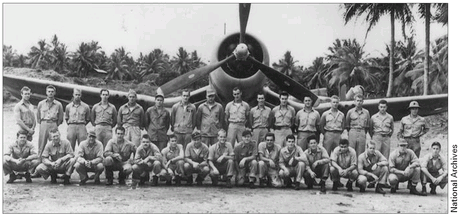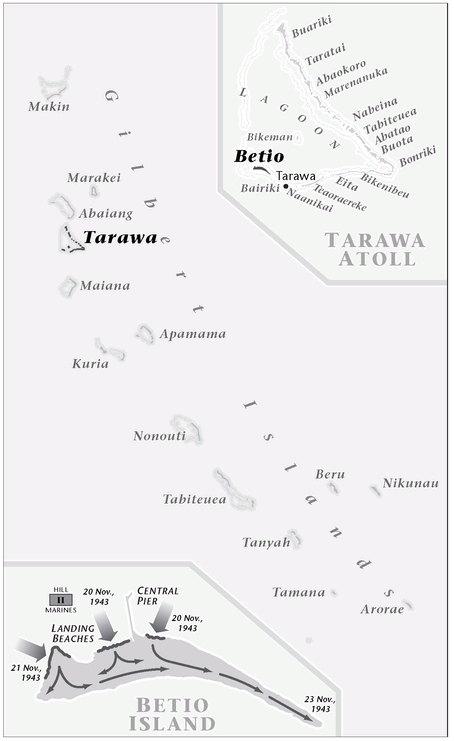War Stories II (42 page)
Authors: Oliver L. North

LIEUTENANT W. THOMAS EMRICH, USMC
Vella Lavella Island
29 October 1943
1315 Hours Local
Vella Lavella Island
29 October 1943
1315 Hours Local

I remember vividly that first time. We didn't see any enemy airplanes at first, on my first mission. And suddenly about sixty Zeros appear. There's probably thirty or so of us from various squadrons. So airplanes are all around. You look off to the left, there's airplanes going down in flames. There are airplanes crossing twenty feet in front of you. And I think, what am I doing here? I'm scared to death. My mouth was so dry, if you'd have called me on the radio, I couldn't have answered you. That's how scared I was.
On October 17 I shot down two Zerosâtwo on the same day. You have to remember that the Zero had no armor plate and no self-sealing fuel tanks. Their fuel tank was behind the cockpit. And both the airplanes I shot down, I came in from behind. They never saw me. And when I fired, the Zero just exploded because my bullets were incendiary and the gas tank behind the pilot blew up. You never saw them again. It's obvious when they're on fire that they're finished.
In such fights, you're not only flying the airplane, you're shooting six guns. It isn't just flying skill that counts. It was also marksmanship.
The next tour after that, we were flying along in an overcast of 800 feet after we'd come back from an aborted mission. We were flying at about 500 feet and you can imagine what these Japanese thought, with eight Corsairs, passing 300 to 400 feet over them.
About a minute or two later, my engine quit. I tried to turn on the other fuel pump and check the tanks. Before that time, I'd always thought,
If something happens, do I want to make a water landing or bail out?
Well, at 500 feet I didn't have any choice about bailing out. So it was going to be a water landing. But the engine quit and the airplane slowed down, and when I hit the ocean, water gets right up to my windshield. Naturally I try to get out. I climb onto the wing, jump off into the water, and the airplane disappears. That's how fast it was.
If something happens, do I want to make a water landing or bail out?
Well, at 500 feet I didn't have any choice about bailing out. So it was going to be a water landing. But the engine quit and the airplane slowed down, and when I hit the ocean, water gets right up to my windshield. Naturally I try to get out. I climb onto the wing, jump off into the water, and the airplane disappears. That's how fast it was.
And my friend Ed Harper starts circling to see that his buddy was okay, and calls for some assistance. In about an hour a boat came out, picked me up, and took me to shore. There was an auxiliary field there, and another Army plane came and flew me back to base.
 MARINE FIGHTER SQUADRON VMF-214
MARINE FIGHTER SQUADRON VMF-214CAPE TOROKINA BEACHHEAD
EMPRESS AUGUSTA BAY, BOUGAINVILLE
27 DECEMBER 1943
0940 HOURS LOCAL
EMPRESS AUGUSTA BAY, BOUGAINVILLE
27 DECEMBER 1943
0940 HOURS LOCAL
In mid-November, U.S. Marine Raiders from the 3rd Infantry Division finally landed at Bougainville, where the Japanese least expected. They were followed by 34,000 Marines and Army troops, who, having bypassed the enemy garrisons on the south coast, sailed halfway up the western side of the island before going ashore just north of Empress Augusta Bay at Cape Torokina.
The bulk of the Japanese forces in Rabaul, far to the south, needed time to move troops and equipment across the island to hold back the Americans. By that time, the Seabeesâwith the help of an engineer brigade from New Zealandâhad finished two airstrips while the infantry established a
secure beachhead. The Allies were actually making some headway when the Japanese finally came up from the south.
secure beachhead. The Allies were actually making some headway when the Japanese finally came up from the south.
Â
The Black Sheep Squadron in front of a Corsair on Vella Lavella.

Combat on Bougainville was terrible, with the jungle and terrain even worse and more unforgiving than those on Guadalcanal.
By the time Bougainville was partially secured, Major Boyington and the squadron had returned from R & R to the forward base at Vella Lavella. There, Boyington learned that he had nineteen new men to train. But Pappy wanted a more challenging target than Bougainville and suggested the fortified Japanese base at Rabaul. His old friend General “Nuts” Moore gave him the go-ahead.
On 17 December 1943, Boyington led the first single-engine fighter sweep across Rabaul. The Japanese forces at Rabaul had been steadily worn down by Allied bombing and strafing attacks, by both MacArthur's air force and the Black Sheep Squadron. This day Pappy Boyington's pilots would be up against more than two hundred Zeros and their pilots, who knew how to fight the Marine Corsairs.
The Japanese shot down six Black Sheep pilots on their first two runs on Rabaul. But at the end of the day Boyington alone had a total of twenty kills to his creditâjust six fewer than the American record held by Joe Foss and Eddie Rickenbacker. On 23 December he knocked down four more, closing the gap even more.
A press corps interviewer asked Pappy if any Japanese planes showed up to attack the Black Sheep Squadron. He replied, “Yes, there were a number of Japanese planes that came up over there . . . and we got all we could in dogfights. And I saw eight other planes destroyed besides the four I destroyed myself.”
The next night, at a base Christmas party, he boasted, “They can't kill me. If you ever see me with thirty Zeros on my tail, don't worry. I'll be all right. I'll meet you six months after the war in a bar in San Diego and we'll all have a drink for old time's sake.”
Ten days later, Major Gregory “Pappy” Boyington was shot down in a running gun battle in the skies just off the coast of Rabaul. But he didn't go quietly. Before his plane disappeared into the sea, he was seen burning another enemy Zeroâhis twenty-fifthâone short of the all-time record.
Boyington's disappearance created a press and public relations frenzy. Rumors were rampant. The
New York Times
reported that Major Boyington was alive on an island, hidden by natives and waiting to rejoin the squadron. There were other guesses as to what happened. None of the stories about his disappearance were true.
New York Times
reported that Major Boyington was alive on an island, hidden by natives and waiting to rejoin the squadron. There were other guesses as to what happened. None of the stories about his disappearance were true.
No one but the Japanese knew that Pappy Boyington had been shot down and picked up in the water by a Japanese sub. He was taken to Japan and only resurfaced at the war's end, when his name showed up on a list of American POWs.
The Marine Black Sheep Squadron fell apart after its leader had been missing in action for several months. VMF-214 was officially disbanded in March 1944. The men of the formerly tight-knit squadron went their separate ways. Some returned home to the U.S. for duty while others were reassigned to other units in the Pacific.
MacArthur and Halseyâwith the help of the Black Sheepâhad effectively isolated the Japanese on Rabaul. Cut off from supplies or evacuation and virtually abandoned by their leaders, Rabaul's garrison of more than 100,000 Imperial troops were allowedâin the words of Admiral Halseyâto “wither on the vine.” From early 1944 to the end of the war in August 1945 the garrison received no food, supplies, or reinforcements.
When Japanese commanders surrendered Rabaul after the war, among the 101,000 troops still on the island fortress were five divisions commanded by nineteen army generals and eleven admirals of the Imperial Navy contingent.

CHAPTER 11
BLOODY TARAWA
(NOVEMBER 1943)
 USS MARYLAND, FLAGSHIP, U.S. 5TH AMPHIBIOUS FORCE
USS MARYLAND, FLAGSHIP, U.S. 5TH AMPHIBIOUS FORCETARAWA, BETIO ISLAND
20 NOVEMBER 1943
0800 HOURS LOCAL
20 NOVEMBER 1943
0800 HOURS LOCAL
A
s Rear Admiral Harry Hill watched from the bridge of his flagship, the largest amphibious assault yet tried in the Pacific was finally under way. Called Operation Galvanic, it aimed to capture the Gilbert Islands in the first phase of a new central Pacific offensiveâa strategy long advocated by Admiral Chester Nimitz and bitterly opposed by General Douglas MacArthur.
s Rear Admiral Harry Hill watched from the bridge of his flagship, the largest amphibious assault yet tried in the Pacific was finally under way. Called Operation Galvanic, it aimed to capture the Gilbert Islands in the first phase of a new central Pacific offensiveâa strategy long advocated by Admiral Chester Nimitz and bitterly opposed by General Douglas MacArthur.
The long struggle to isolate and neutralize Rabaul had built support in Washington for Nimitz's plan. And though MacArthur believed that the road to Tokyo had to go through the Philippines, everyone else was looking for a way to avoid more of the long, bloody battles like those fought in the steaming, mountainous jungles of New Guinea and Guadalcanal.
Operation Cartwheel, the two-pronged Allied approach toward Rabaul launched in the aftermath of Yamamoto's demise, had been a difficult but
resounding success. By the end of October 1943, troops from MacArthur's southwest Pacific command had moved well up the northeast coast of New Guinea and were preparing to land at Cape Gloucester on New Britain. Halsey's South Pacific forces had made parallel progress up through the Russell Islands, Munda, Vella Lavella and Choiseul. On 1 November, the 3rd Marine Division and the Army's 37th Division landed on Bougainville.
resounding success. By the end of October 1943, troops from MacArthur's southwest Pacific command had moved well up the northeast coast of New Guinea and were preparing to land at Cape Gloucester on New Britain. Halsey's South Pacific forces had made parallel progress up through the Russell Islands, Munda, Vella Lavella and Choiseul. On 1 November, the 3rd Marine Division and the Army's 37th Division landed on Bougainville.
Other books
Surrender by June Gray
Belong to Me by Shayla Black
The Valley of the Wendigo by J. R. Roberts
Shine by Star Jones Reynolds
Shift by Kim Curran
The Last Talisman by Licia Troisi
The Cracked Spine by Paige Shelton
Chased by a Stranger (Craved Series #3) by Kelly, Hazel
Days Of Perdition: Voodoo Plague Book 6 by Dirk Patton
Someday_ADE by Lynne Tillman